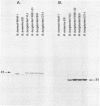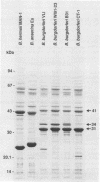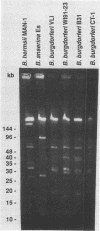Abstract
Field investigations were conducted to further evaluate the role of birds in the maintenance and dissemination of Borrelia burgdorferi. Blood specimens were taken from 39 passerine birds of 17 species captured during June 1991 at the Saint Croix National Riverway in Wisconsin, and one isolate, WI91-23, was cultured from an adult song sparrow (Melospiza melodia). This isolate was shown to be infectious for Peromyscus leucopus and Mesocricetus auratus (golden hamster). Isolate WI91-23 was confirmed as B. burgdorferi by immunofluorescence assay by using species-specific anti-OspA monoclonal antibodies H3TS and H5332 and anti-OspB antibody H5TS. Isolate WI91-23 was compared with Borrelia anserina Es, Borrelia hermsii MAN-1, and other B. burgdorferi strains (ATCC 53210, CT-1, and Catharus fuscescens [veery] liver 10293). Pulsed-field gel electrophoresis of in situ-lysed spirochetes revealed that the DNA plasmid profile of WI91-23 was most similar to those of plasmids from B. burgdorferi and most different from those of plasmids from B. anserina and B. hermsii. Sodium dodecyl sulfate-polyacrylamide gel electrophoresis analysis indicated that the protein profile of WI91-23 was like that of other B. burgdorferi strains studied, with dominant proteins corresponding to OspA and OspB, and that it differed from the protein profiles of B. anserina and B. hermsii. These findings indicate that passerine birds may serve as reservoirs for B. burgdorferi.
Full text
PDF
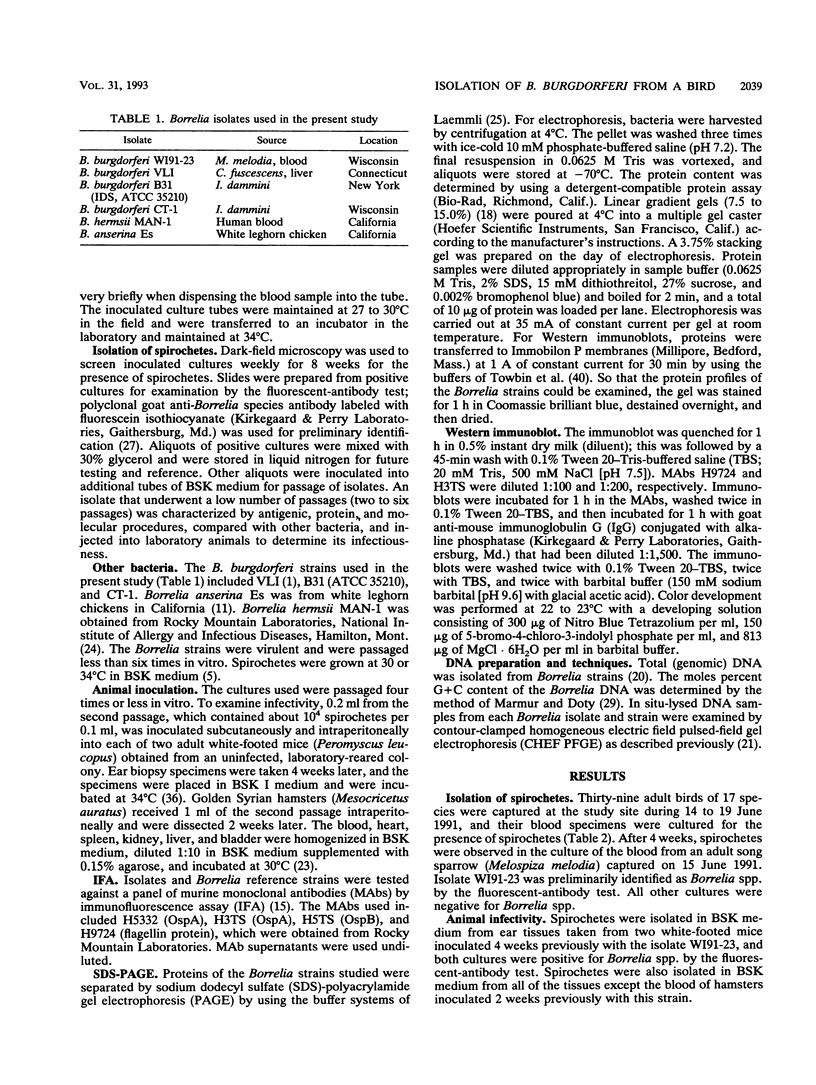
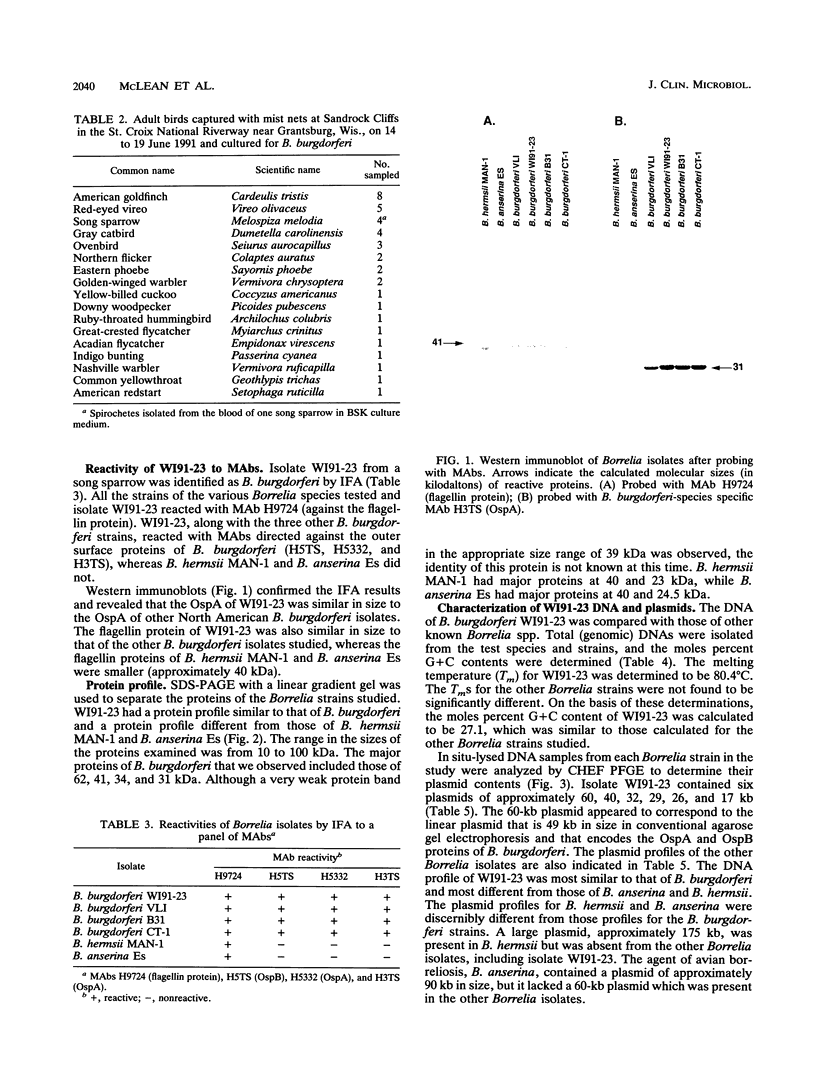
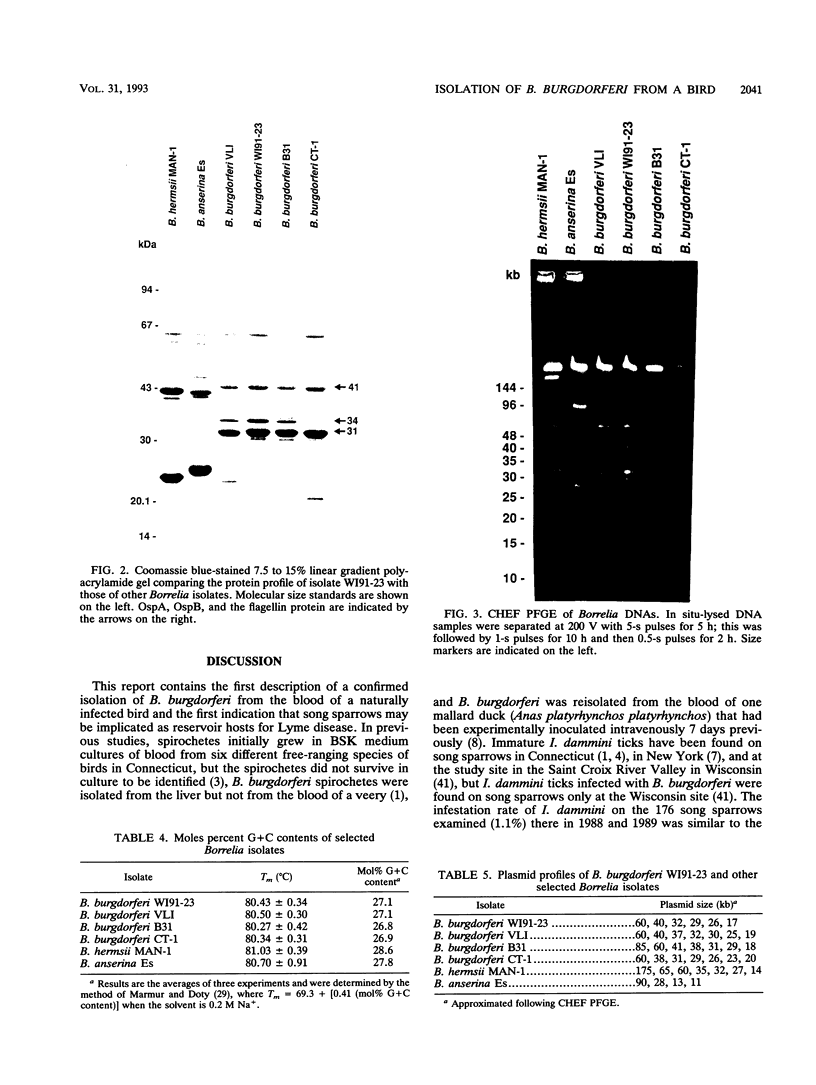
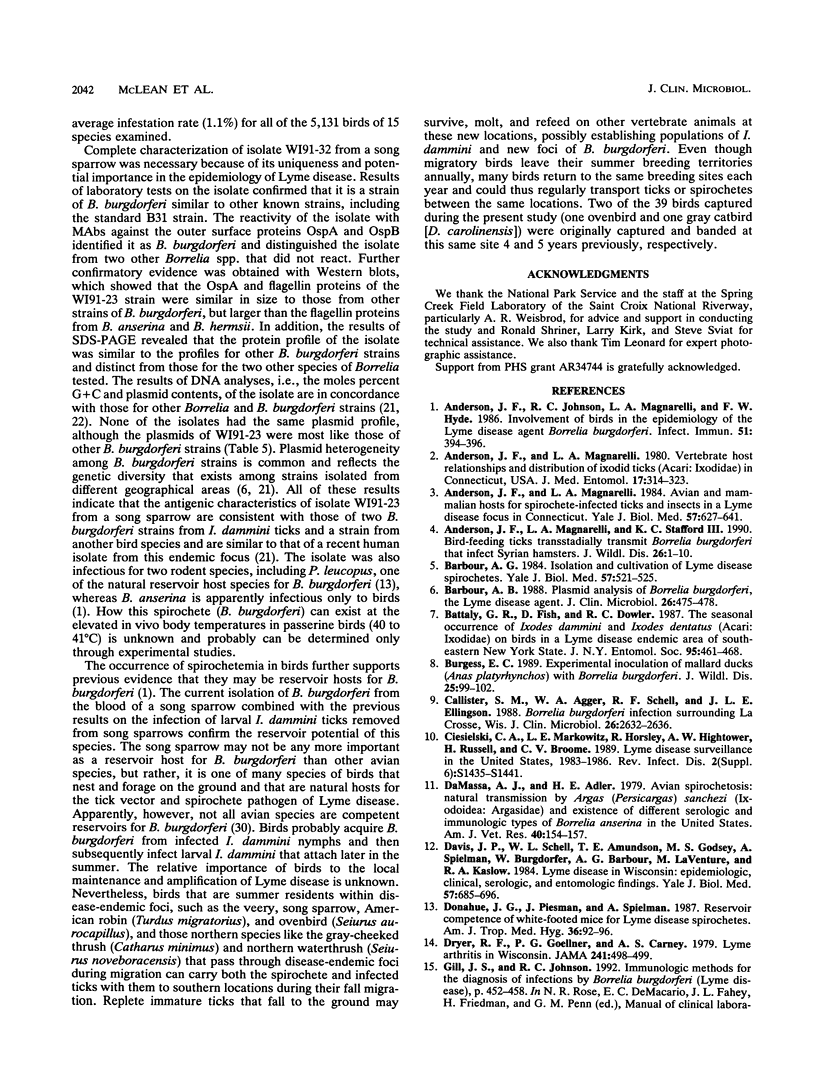

Images in this article
Selected References
These references are in PubMed. This may not be the complete list of references from this article.
- Anderson J. F., Johnson R. C., Magnarelli L. A., Hyde F. W. Involvement of birds in the epidemiology of the Lyme disease agent Borrelia burgdorferi. Infect Immun. 1986 Feb;51(2):394–396. doi: 10.1128/iai.51.2.394-396.1986. [DOI] [PMC free article] [PubMed] [Google Scholar]
- Anderson J. F., Magnarelli L. A. Avian and mammalian hosts for spirochete-infected ticks and insects in a Lyme disease focus in Connecticut. Yale J Biol Med. 1984 Jul-Aug;57(4):627–641. [PMC free article] [PubMed] [Google Scholar]
- Anderson J. F., Magnarelli L. A., Stafford K. C., 3rd Bird-feeding ticks transstadially transmit Borrelia burgdorferi that infect Syrian hamsters. J Wildl Dis. 1990 Jan;26(1):1–10. doi: 10.7589/0090-3558-26.1.1. [DOI] [PubMed] [Google Scholar]
- Anderson J. F., Magnarelli L. A. Vertebrate host relationships and distribution of ixodid ticks (Acari: Ixodidae) in Connecticut, USA. J Med Entomol. 1980 Jul 31;17(4):314–323. doi: 10.1093/jmedent/17.4.314. [DOI] [PubMed] [Google Scholar]
- Barbour A. G. Isolation and cultivation of Lyme disease spirochetes. Yale J Biol Med. 1984 Jul-Aug;57(4):521–525. [PMC free article] [PubMed] [Google Scholar]
- Barbour A. G. Plasmid analysis of Borrelia burgdorferi, the Lyme disease agent. J Clin Microbiol. 1988 Mar;26(3):475–478. doi: 10.1128/jcm.26.3.475-478.1988. [DOI] [PMC free article] [PubMed] [Google Scholar]
- Burgess E. C. Experimental inoculation of mallard ducks (Anas platyrhynchos platyrhynchos) with Borrelia burgdorferi. J Wildl Dis. 1989 Jan;25(1):99–102. doi: 10.7589/0090-3558-25.1.99. [DOI] [PubMed] [Google Scholar]
- Callister S. M., Agger W. A., Schell R. F., Ellingson J. L. Borrelia burgdorferi infection surrounding La Crosse, Wis. J Clin Microbiol. 1988 Dec;26(12):2632–2636. doi: 10.1128/jcm.26.12.2632-2636.1988. [DOI] [PMC free article] [PubMed] [Google Scholar]
- Ciesielski C. A., Markowitz L. E., Horsley R., Hightower A. W., Russell H., Broome C. V. Lyme disease surveillance in the United States, 1983-1986. Rev Infect Dis. 1989 Sep-Oct;11 (Suppl 6):S1435–S1441. [PubMed] [Google Scholar]
- DaMassa A. J., Adler H. E. Avian spirochetosis: natural transmission by Argas (Persicargas) sanchezi (Ixodoidea: argasidae) and existence of different serologic and immunologic types of Borrelia anserina in the United States. Am J Vet Res. 1979 Jan;40(1):154–157. [PubMed] [Google Scholar]
- Davis J. P., Schell W. L., Amundson T. E., Godsey M. S., Jr, Spielman A., Burgdorfer W., Barbour A. G., LaVenture M., Kaslow R. A. Lyme disease in Wisconsin: epidemiologic, clinical, serologic, and entomologic findings. Yale J Biol Med. 1984 Jul-Aug;57(4):685–696. [PMC free article] [PubMed] [Google Scholar]
- Donahue J. G., Piesman J., Spielman A. Reservoir competence of white-footed mice for Lyme disease spirochetes. Am J Trop Med Hyg. 1987 Jan;36(1):92–96. doi: 10.4269/ajtmh.1987.36.92. [DOI] [PubMed] [Google Scholar]
- Dryer R. F., Goellner P. G., Carney A. S. Lyme arthritis in Wisconsin. JAMA. 1979 Feb 2;241(5):498–499. [PubMed] [Google Scholar]
- Godsey M. S., Jr, Amundson T. E., Burgess E. C., Schell W., Davis J. P., Kaslow R., Edelman R. Lyme disease ecology in Wisconsin: distribution and host preferences of Ixodes dammini, and prevalence of antibody to Borrelia burgdorferi in small mammals. Am J Trop Med Hyg. 1987 Jul;37(1):180–187. doi: 10.4269/ajtmh.1987.37.180. [DOI] [PubMed] [Google Scholar]
- HOOGSTRAAL H., KAISER M. N. Ticks from European-Asiatic birds migrating through Egypt into Africa. Science. 1961 Jan 27;133(3448):277–278. doi: 10.1126/science.133.3448.277. [DOI] [PubMed] [Google Scholar]
- Hughes C. A., Johnson R. C. Methylated DNA in Borrelia species. J Bacteriol. 1990 Nov;172(11):6602–6604. doi: 10.1128/jb.172.11.6602-6604.1990. [DOI] [PMC free article] [PubMed] [Google Scholar]
- Hughes C. A., Kodner C. B., Johnson R. C. DNA analysis of Borrelia burgdorferi NCH-1, the first northcentral U.S. human Lyme disease isolate. J Clin Microbiol. 1992 Mar;30(3):698–703. doi: 10.1128/jcm.30.3.698-703.1992. [DOI] [PMC free article] [PubMed] [Google Scholar]
- Johnson R. C., Hyde F. W., Rumpel C. M. Taxonomy of the Lyme disease spirochetes. Yale J Biol Med. 1984 Jul-Aug;57(4):529–537. [PMC free article] [PubMed] [Google Scholar]
- Johnson R. C., Marek N., Kodner C. Infection of Syrian hamsters with Lyme disease spirochetes. J Clin Microbiol. 1984 Dec;20(6):1099–1101. doi: 10.1128/jcm.20.6.1099-1101.1984. [DOI] [PMC free article] [PubMed] [Google Scholar]
- Kurashige S., Bissett M., Oshiro L. Characterization of a tick isolate of Borrelia burgdorferi that possesses a major low-molecular-weight surface protein. J Clin Microbiol. 1990 Jun;28(6):1362–1366. doi: 10.1128/jcm.28.6.1362-1366.1990. [DOI] [PMC free article] [PubMed] [Google Scholar]
- Laemmli U. K. Cleavage of structural proteins during the assembly of the head of bacteriophage T4. Nature. 1970 Aug 15;227(5259):680–685. doi: 10.1038/227680a0. [DOI] [PubMed] [Google Scholar]
- Lord R. D., Humphreys J. G., Lord V. R., McLean R. G., Garland C. L. Borrelia burgdorferi infection in white-footed mice (Peromyscus leucopus) in hemlock (Tsuga canadensis) habitat in western Pennsylvania. J Wildl Dis. 1992 Jul;28(3):364–368. doi: 10.7589/0090-3558-28.3.364. [DOI] [PubMed] [Google Scholar]
- MARMUR J., DOTY P. Determination of the base composition of deoxyribonucleic acid from its thermal denaturation temperature. J Mol Biol. 1962 Jul;5:109–118. doi: 10.1016/s0022-2836(62)80066-7. [DOI] [PubMed] [Google Scholar]
- Magnarelli L. A., Anderson J. F., Fish D. Transovarial transmission of Borrelia burgdorferi in Ixodes dammini (Acari:Ixodidae). J Infect Dis. 1987 Jul;156(1):234–236. doi: 10.1093/infdis/156.1.234. [DOI] [PubMed] [Google Scholar]
- Mather T. N., Telford S. R., 3rd, MacLachlan A. B., Spielman A. Incompetence of catbirds as reservoirs for the Lyme disease spirochete (Borrelia burgdorferi). J Parasitol. 1989 Feb;75(1):66–69. [PubMed] [Google Scholar]
- Pinger R. R., Glancy T. Ixodes dammini (Acari: Ixodidae) in Indiana. J Med Entomol. 1989 Mar;26(2):130–131. doi: 10.1093/jmedent/26.2.130. [DOI] [PubMed] [Google Scholar]
- Scrimenti R. J. Erythema chronicum migrans. Arch Dermatol. 1970 Jul;102(1):104–105. [PubMed] [Google Scholar]
- Siegel J. P., Kitron U., Bouseman J. K. Spatial and temporal distribution of Ixodes dammini (Acari: Ixodidae) in a northwestern Illinois state park. J Med Entomol. 1991 Jan;28(1):101–104. doi: 10.1093/jmedent/28.1.101. [DOI] [PubMed] [Google Scholar]
- Sinsky R. J., Piesman J. Ear punch biopsy method for detection and isolation of Borrelia burgdorferi from rodents. J Clin Microbiol. 1989 Aug;27(8):1723–1727. doi: 10.1128/jcm.27.8.1723-1727.1989. [DOI] [PMC free article] [PubMed] [Google Scholar]
- Steere A. C., Grodzicki R. L., Kornblatt A. N., Craft J. E., Barbour A. G., Burgdorfer W., Schmid G. P., Johnson E., Malawista S. E. The spirochetal etiology of Lyme disease. N Engl J Med. 1983 Mar 31;308(13):733–740. doi: 10.1056/NEJM198303313081301. [DOI] [PubMed] [Google Scholar]
- Towbin H., Staehelin T., Gordon J. Electrophoretic transfer of proteins from polyacrylamide gels to nitrocellulose sheets: procedure and some applications. Proc Natl Acad Sci U S A. 1979 Sep;76(9):4350–4354. doi: 10.1073/pnas.76.9.4350. [DOI] [PMC free article] [PubMed] [Google Scholar]
- Weisbrod A. R., Johnson R. C. Lyme disease and migrating birds in the Saint Croix River Valley. Appl Environ Microbiol. 1989 Aug;55(8):1921–1924. doi: 10.1128/aem.55.8.1921-1924.1989. [DOI] [PMC free article] [PubMed] [Google Scholar]



